Behind every stable grid and on-time infrastructure upgrade lies a planning team making high-stakes supply decisions often with limited time, fragmented data, and rising pressure.
In today’s utility landscape, supply chains aren’t just operational engines; they’re strategic levers. And planning heads sit right at the fulcrum of cost, resilience, and continuity.
At DTskill, we’ve worked closely with utility leaders navigating everything from renewable integration to rapid grid expansion. One theme keeps coming up: the need for a smarter, faster, and more agile supply chain without disrupting what already works. That’s exactly where AI fits in. It’s not a rip-and-replace tool; it’s a layer of intelligence that helps existing systems think and respond in real-time.
This blog isn’t just about AI features; it’s a practical, 5-step roadmap tailored for planning heads in utilities. Whether you’re handling long-cycle procurement, outage-related inventory shifts, or multi-region demand fluctuations, we’ll show you how to build an AI-ready supply chain that empowers your team to anticipate, adapt, and lead with clarity
Unlocking More Value from Existing Systems
Planning heads across utilities have already built reliable foundations, ERP systems to track procurement, inventory platforms to manage stock levels, and supplier portals to coordinate orders. These tools offer visibility, structure, and consistency. But they were designed for a world where demand was more predictable, projects followed linear timelines, and data didn’t move in real time.
Today, the pace has changed. Supply chain disruptions happen overnight. Outage timelines shift with weather forecasts. Renewable energy inputs can reshape regional demand within hours. In this environment, the value of existing systems lies not just in what they record, but in how quickly they can adapt.
That’s where AI acts as a force multiplier. Instead of overhauling legacy tools, AI layers intelligence on top, connecting siloed systems, spotting early risk signals, and generating proactive recommendations. Think of it as giving your current platforms the ability to sense, learn, and respond faster, helping planning teams make better decisions without overhauling processes that already work.
What an AI-Ready Supply Chain Looks Like
An AI-ready supply chain isn’t defined by the tools it uses; it’s defined by how those tools work together to respond faster, think ahead, and support planning teams at every turn. In the utility sector, that means creating a system that can flex with demand, foresee disruptions, and coordinate decisions across teams without delays.
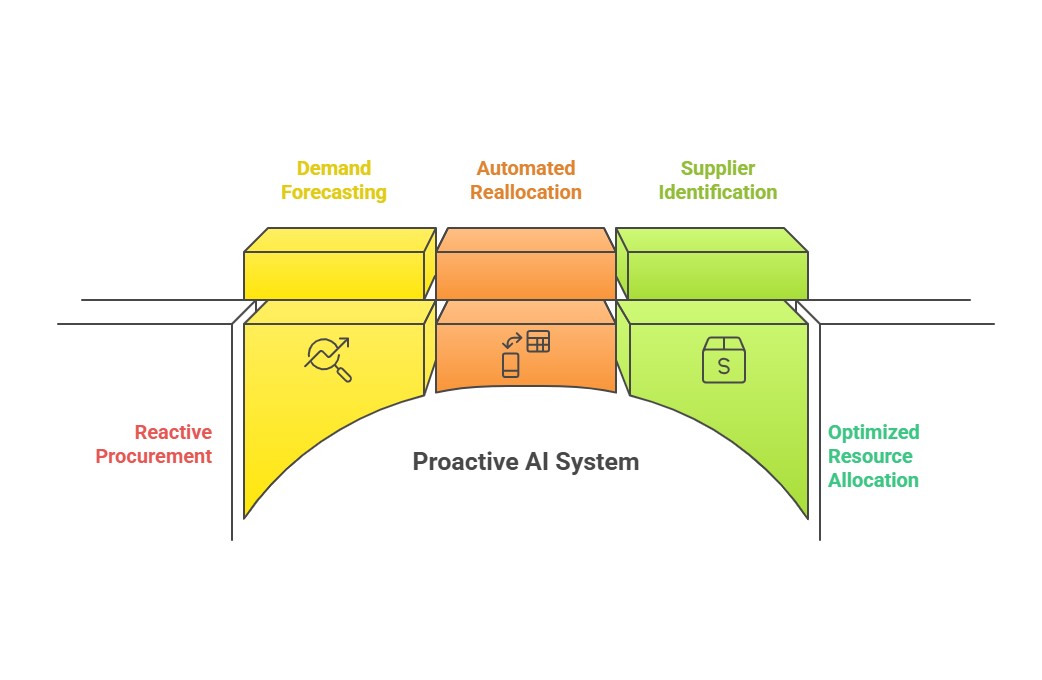
Imagine this:
- When a sudden change in regional energy demand is detected, the system not only forecasts its impact on material needs but also alerts procurement to adjust orders and reroute shipments in real-time.
- If a substation upgrade is delayed due to weather, the inventory system automatically reallocates components to another high-priority site without manual intervention.
- And when a critical part is predicted to run low, AI highlights alternate suppliers with shorter lead times and lower risk, before it becomes a bottleneck.
That’s the power of being AI-ready. It’s not just automation, it’s coordination, foresight, and agility built into the everyday supply chain workflow. It gives planning heads the visibility and control they need to move from reactive problem-solving to strategic orchestration.
Step 1 – Connect & Clean Your Data
Before AI can enhance supply decisions, it needs access to the right data that is structured, connected, and trustworthy. This step is about laying the digital foundation: breaking down data silos and preparing your systems to talk to each other in real time.
How to Execute This Step Successfully:
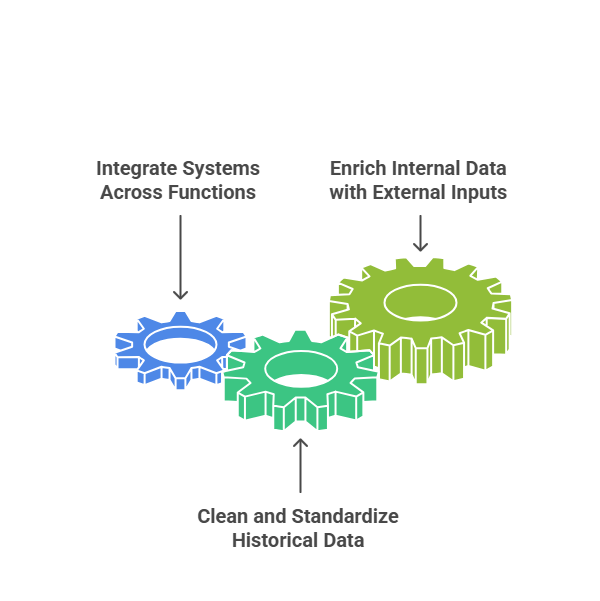
- Integrate Systems Across Functions:
Connect planning, procurement, inventory, logistics, and field ops into a unified data flow. Use APIs, data pipelines, or middleware to ensure systems like ERP, WMS, and supplier portals share real-time signals. - Clean and Standardize Historical Data:
Identify inconsistencies in naming conventions, units, supplier codes, and location tags. Use AI tools to automate data cleansing and standardization across warehouses and regional teams. - Enrich Internal Data with External Inputs:
Bring in external datasets such as weather forecasts, transportation availability, and commodity pricing to improve the context and accuracy of supply planning.
What Success Looks Like:
Your data infrastructure becomes a living layer where every stakeholder sees the same version of truth, in real-time. Inventory positions auto-refresh, demand signals are instantly visible, and planning heads can make confident decisions backed by connected clean intelligence.
Step 2 – Predict Demand & Disruptions
Once data is connected and clean, the next step is making it work ahead of time. AI enables planning heads to move beyond historical trends and generate dynamic forecasts that reflect current conditions and anticipate future shifts.
How to Execute This Step Successfully:
- Implement AI-Based Demand Forecasting Models:
Use AI to analyze consumption patterns, outage schedules, asset upgrade plans, and regional variables to predict material requirements with greater accuracy. - Build Disruption Prediction Layers:
Incorporate AI models that track weather, supplier reliability, transport delays, and inventory movement to flag potential disruptions before they impact supply timelines. - Visualize Forecasts Across Time Horizons:
Provide planners with short-term (weekly), medium-term (quarterly), and long-term (annual) views so they can adjust orders, stock, and supplier choices based on changing priorities.
What Success Looks Like:
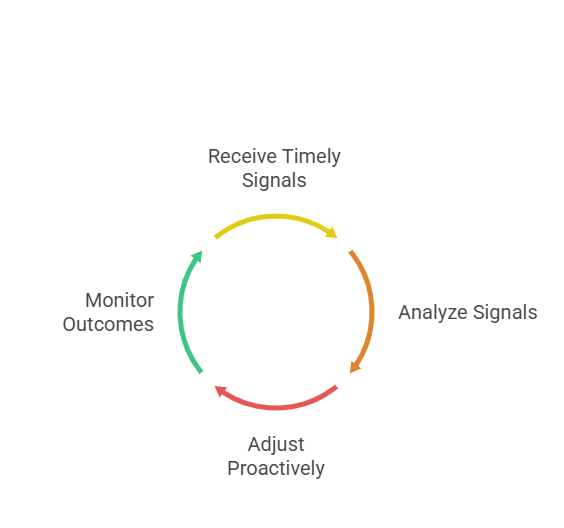
You no longer plan around fixed assumptions. Instead, your team receives timely signals like a forecasted surge in transformer demand or a predicted delay in copper cable shipments and can adjust proactively instead of reacting late.
Step 3 – Optimize Procurement Decisions
Procurement isn’t just about sourcing materials; it’s about balancing cost, speed, reliability, and risk. AI helps teams weigh these trade-offs at scale, turning procurement into a strategic function.
How to Execute This Step Successfully:
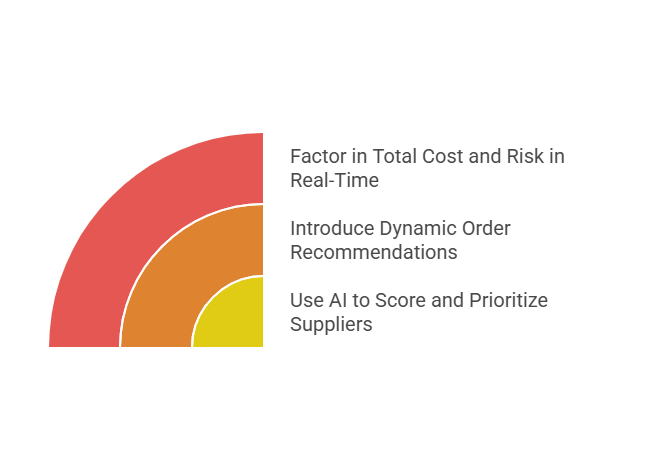
- Use AI to Score and Prioritize Suppliers:
Evaluate vendors based on delivery performance, lead time variability, risk exposure, and pricing trends to make more informed sourcing decisions. - Introduce Dynamic Order Recommendations:
Allow AI to suggest optimal order quantities and timing based on predicted demand, supplier capacity, and market conditions, helping avoid both overstock and shortages. - Factor in Total Cost and Risk in Real-Time:
Equip buyers with AI insights that include freight rates, geopolitical risks, and material availability to make procurement decisions that align with both budget and reliability goals.
What Success Looks Like:
Every procurement decision becomes faster and smarter, orders are placed earlier, risks are flagged ahead of time, and planners can shift vendors or renegotiate with confidence backed by data.
Step 4 – Automate Logistics & Inventory
Even the best procurement plan needs real-time logistics and inventory orchestration to succeed. AI brings agility to movement and storage, ensuring that what’s needed arrives where and when it’s needed, without overburdening teams.
How to Execute This Step Successfully:
- Automate Route Optimization and Delivery Scheduling:
Use AI to plan transportation routes dynamically based on demand urgency, site location, traffic, and cost, especially for time-sensitive outage work or remote sites. - Deploy Predictive Inventory Controls:
Forecast stock needs to be based on usage patterns, project schedules, and historical consumption to maintain optimal stock levels across warehouses. - Trigger Auto-Replenishment Rules:
Set thresholds where AI automatically raises purchase requests or reallocates stock when levels fall below defined ranges, keeping field teams ready without manual intervention.
What Success Looks Like:
Inventory moves like clockwork, without excess stock sitting idle or critical components going out of stock. Materials arrive just in time for scheduled outages or emergencies, and planners have full visibility into every link in the logistics chain.
Step 5 – Align for End-to-End Agility
Planning excellence doesn’t happen in silos. AI’s full impact comes when it enables coordination across planning, procurement, field operations, and logistics, so the entire supply chain moves as one.
How to Execute This Step Successfully:
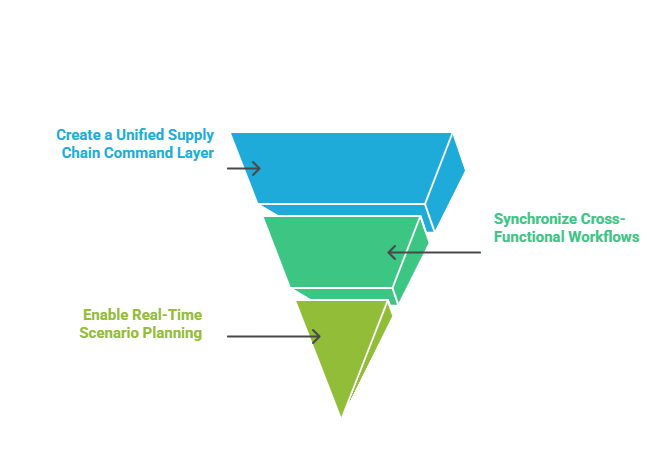
- Create a Unified Supply Chain Command Layer:
Set up dashboards and control towers that centralize AI insights across procurement, logistics, and inventory, giving planners one view to act from. - Synchronize Cross-Functional Workflows:
Use AI to trigger workflows across teams when a delay is forecasted, procurement, logistics, and field teams are all notified and realigned instantly. - Enable Real-Time Scenario Planning:
Let planning heads simulate different supply chain scenarios (e.g., a delayed shipment or demand spike) and see their downstream impact to make faster, more resilient decisions.
What Success Looks Like:
Your supply chain becomes a living, breathing system. Decisions made by procurement ripple seamlessly into field ops. Logistics adjusts in real-time. Planning teams gain the agility to respond in hours, not weeks, unlocking a new level of speed, resilience, and control.
Strategic Wins for Planning Heads
Building an AI-ready supply chain does more than streamline operations; it redefines the strategic potential of the planning function in utilities. Here’s what planning heads gain when AI becomes an enabler, not just a tool:
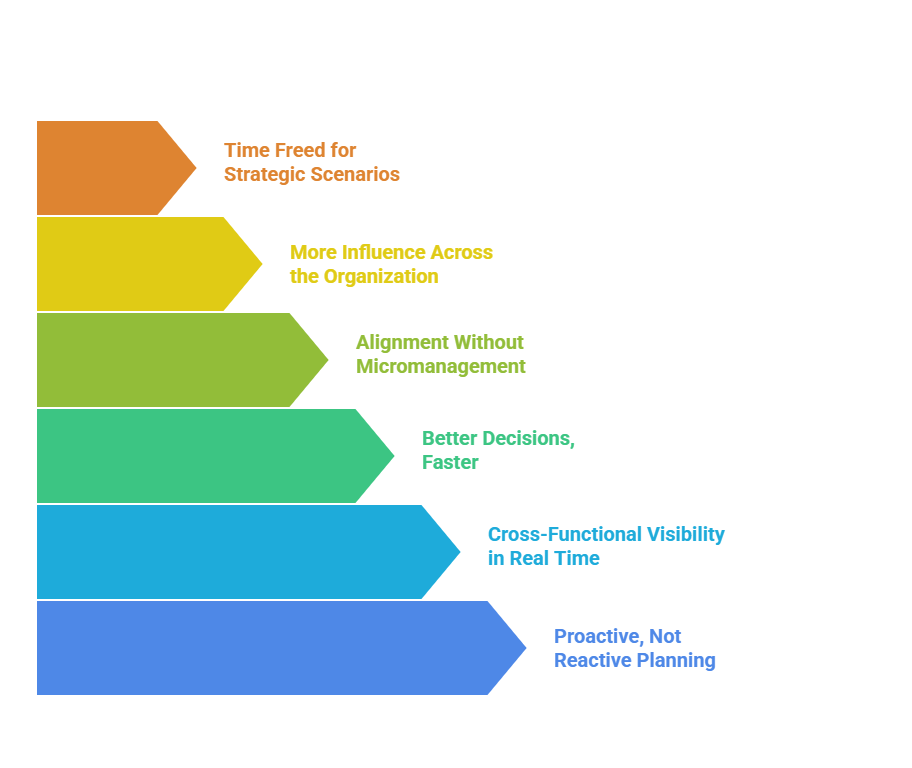
- Proactive, Not Reactive Planning
With AI-generated forecasts and risk alerts, planning leaders can act before disruptions occur, whether it’s a supplier delay, a weather-related outage, or a demand spike. - Cross-Functional Visibility in Real Time
AI breaks down silos across procurement, logistics, and inventory, giving planning heads a centralized view of what’s moving, what’s stuck, and what needs action. - Better Decisions, Faster
AI reduces the burden of manual analysis by serving up prioritized recommendations, supplier comparisons, and cost-risk trade-offs so planners can make smarter calls under pressure. - Alignment Without Micromanagement
When AI automates routine tasks like stock monitoring or route adjustments, planners can trust the system to handle the details and focus on strategy. - More Influence Across the Organization
As supply chains become more agile, planning heads become key enablers of project execution, grid reliability, and regulatory readiness, earning a stronger voice at the leadership table. - Time Freed for Strategic Scenarios
With fewer fire drills, planning heads can finally focus on high-impact work like scenario planning, sustainability sourcing, and long-term capacity strategy.
Future Outlook
As utilities face growing volatility driven by renewables, aging infrastructure, and regulatory shifts, the supply chain is becoming the backbone of resilience. The next frontier? Systems that don’t just respond faster, but learn and improve with every cycle.
We’re entering an era where:
- Supply systems adapt automatically to project delays or field conditions
- AI agents coordinate between suppliers, transporters, and site managers autonomously
- Strategic sourcing models balance cost, carbon impact, and regional risk in real time
- Simulation tools help planning teams test “what-if” scenarios before making a move
For planning heads, the shift isn’t about chasing the next tool; it’s about architecting a system that evolves with your business. One where intelligence is embedded into every link of the supply chain and agility is built into its core.
The supply chain of the future won’t just be smarter, it will be self-aware, self-adjusting, and deeply aligned to operational goals. And planning leaders will be the ones driving that transformation forward.
Ready to Make Your Supply Chain AI-Ready?
The roadmap is in place. Now it’s about taking the first step, turning data into decisions, and supply chains into strategic assets.
Want to see how this applies to your operations?
Let’s talk.
